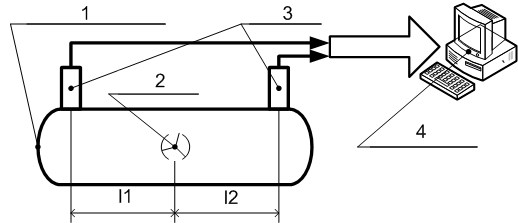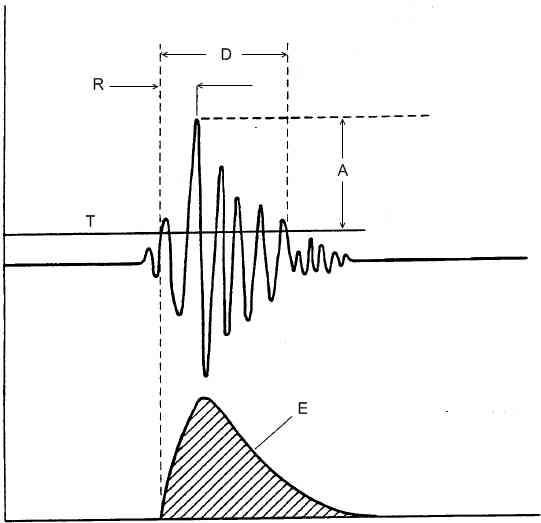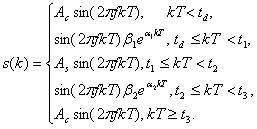
Theme of master's work: Development of a Computerized Training Information System Condition Monitoring for Industrial Sites Using the Acoustic Emission Method
SUMMARY OF RESEARCH AND DEVELOPMENTS
INTRODUCTION
A large number of modern industries need to use non-destructive methods of testing to determine the number and degree of development, the location of defects in the internal structure of the materials from which the object is made: it controls should be carried out directly during the technological process that does not allow to violate the integrity of the object. If you have knowledge about the dynamics of defect formation it is possible to predict the time approximation of the object to the destruction. If it is so you can take the necessary measures to prevent accidents. The basic principle of engineering structures diagnostics is a passive collection of information from a multitude of sound (and ultrasonic) sensors, and its processing for subsequent determination of the degree of destruction. The issue for such kind of monitoring is given in [1].
1 RELEVANCE OF THE TOPIC
Recently, dynamically growing number of publications on the use of the method of acoustic emission monitoring (AE-control). It has several advantages over other methods of non-destructive testing due to its characteristics, given in [2]:
- AE-control method provides the detection and recording of defects developing and it is possible to classify the defects not after their size but the degree of their danger;
- AE monitoring method is sensitive to defects grow; it reveals the working conditions of crack growth is very small sizes; sensitivity of acoustic-emission apparatus according to theoretical estimates is about10-6mm2 and it allows to determine the crack growth 1 micron in size 1 micron;
- AE-control method's properties of integrity provides the ability to control the object using one or more converters still mounted on the surface of the object;
- AE-control method allows for control of various technological processes and changes in the properties and condition of materials;
- location and direction of the object does not affect the possibility of a defect;
- AE-control method has less restrictions relating to the properties and structure of materials.
On December 1, 1997 in Ukraine enacted "Regulations on surveys, certification, safe and reliable operation of industrial buildings and structures," according to which the technical diagnosis of reinforced concrete structures must be diagnosed with the use of interrelated and mutually-finding, numerical and analytical procedures . Loss of strength of concrete objects is not instantaneously, but gradually. So it is possible to monitor the dynamics of defects, cracks and make a consideration about the degree of residual margin using the AE-monitoring. Due to a number of advantages over other types of non-destructive testing this method is attractive for use and new research.
2 PLANNED SCIENTIFIC NOVELTY
A special feature of the method of acoustic emission-control system which limits its application in some cases is the difficulties associated with highlighting the signals of acoustic emission (AE) on the background noise (as the AE signals is noise-like in nature).
Modern systems using the method of AE-control basically require the presence of the operator to analyze the data of acoustic emission. It will be very usefull to postpone the analysis of the spectral characteristics to the machine part of a system. That may reduce the risk of subjective operator error and release a certain amount of his time. In carrying out the work of master planned design the system which combine traditional methods of data analysis of the main process' macroparameters and methods for identifying constraints and real audio signals using neural networks (such methods received the popularity in recent years). This would make it possible to compare the results obtained by different means of analysis acoustic data. This will give opportunities to experiment with choosing different sets analyzed macroparameters and the choice of different configurations of neural networks in the search for optimal solutions.
3 REVIEW OF AE-METHOD RESEARCH
Master's thesis will be performed as part of the Cathedral scientific work M-3-07 "Development of scientific fundamentals of building systems for technical and medical diagnostics". As a result of the search among materials of Master's portal (DonNTU) were found works by R. Solomichev, J. Belinskaya, O. Kardybanskii, which refer to the method of AE, but the question of its application is not the main question in these works.
There was registered have been reported from the State budget topic № 6902/21 (№ state registration 0102U001185) "Developing methods of technical diagnostics of highway bridges using acoustic emission method", № 6953 (№ state registration 0103U001353) "Investigation of the stress-strain state of bridge structures' elements using acoustic emission" in Ukraine. It should highlight carried out in accordance with the plans of those themes work [3].
Ukraine has an outstanding scientist who deals with the application of acoustic emission method in flaw detection. His name is V. Sakalsky; he published more than 250 scientific papers on this topic.
There are associations of scientists actively involved in the AE-monitoring, such as European Working group on Acoustic Emission (EWGAE), which held a conference [4] in Kharkov. There are many such organizations all over the world:
- The Acoustic Emission Working Group (AEWG);
- The Japanese Committee on Acoustic Emission (JCAE);
- The Latin American Acoustic Emission Group (GLEA);
- Vallen Systeme GmbH, The Acoustic Emission Company;
- Physical Acoustics Corporation, Acoustic Emission Measurement Technologies;
- Interunis, Systems of Industrial Monitoring Company.
There are numerous publications in Russian, describing and analyzing aspects of applying the method of AE. A list of them can be found on the portal [5]. The program "Open AE Initiative" was created by author of [5] for the exchange of research experience. There should be noted the publication "Acoustic Emission Journal" in the U.S.A., as well as the magazine of the Russian Academy of Sciences "Fault Detection".
4 STATEMENT OF RESEARCH OBJECTIVES
The goal of research is the search the ways for building software and hardware solutions for technical diagnostics. This solution may determine the degree of the object's destruction by elucidating the number, size and location of defects in its internal structure. Achieving this goal can be subject to the following tasks:
registration of acoustic data; Identification of acoustic emission pulses in noise; Classification of pulses of acoustic emission and hence their sources; wear prediction of the object.- registration of acoustic data;
- identification of acoustic emission pulses and noises;
- classification of AE-pulses and hence their sources;
- prediction the time of object's full destruction.
Investigation of possible ways to solve these problems are the main questions that will be researched in master's work.
5 SOLVING THE PROBLEMS AND RESULTS
During implementing the master's work should be designed computerized system. A generalized scheme of such system is shown in Figure 5.1.

Figure 5.1 — Generalized scheme of a computerized control system for industrial sites using the acoustic emission method (animation: volume — 12,8 KB; size — 518x223; amount of shots — 13; frequency of shots changing — 100 ms; amount of repeated cycles — a continuous cycle of reiteration)
In Figure 5.1 the following notation: 1 — the sample, 2 — developing defect, 3 — detector, 4 — center of acoustic data from all channels on the basis of modern computer.
As noted in [6], the basic element of the resonant sensor is a piezoelectric crystal which converts mechanical motion into electrical signal. With the help of sensors the first task listed in the previous section is performed. The last three problems are related to the work on the quantitative characteristics, therefore it is logical to apply to their decision neural networks. Currently, the methods of pattern recognition using neural networks with different structure and specificity, thereby opens a wide space for research. Previously, registration, identification and classification of acoustic pulses was made by well-prepared human operator who rely solely on his subjective auditory sensations. Modern technology allows a computer system that uses a neural network input patterns that are performed with spectral characteristics of acoustic signals.
Obtaining useful information contained in the AE signals is carried out by various methods of quantitative treatment. The number of possible parameters can be quite large. So it is very important to select the most informative parameters carrying the necessary information about the local dynamic restructuring of the internal structure. There is still a weak metrological support of measurements in the field of AE.
[6] illustrates the classic information parameters that must be recorded in the analysis of AE signals, as shown in Figure 5.2.

Figure 5.2 — Standard set of parameters measured by the AE-monitoring system
In Figure 5.2 the following notation are introduced: T — threshold; A — amplitude (the maximum signal value); D — duration (total time of crossing the threshold of the signal prior to being under the threshold); R — time of signals growing (time from first crossing the threshold of the signal until it reaches the maximum amplitude); E — energy parameter (MARSE).
Some modern measuring devices record the spectrum of AE and EAE — the energy of AE signal, which is usually proportional to the length, the square of the amplitude and is determined by the square of the envelope signals which are recorded. The last parameter is called MARSE (Measured Area under the Rectified Signal Envelope); it qualitatively describes the integral behavior of the AE over time, but, unfortunately, does not allow for quantitative evaluation of energy parameters of the formation of defects.
The following parameters characterize discrete AE:
- the total number of impulses — the number of registered AE pulses per time interval;
- AE activity — the total number of pulses comparisons to a unit of time;
- total AE — the number of exceedances (emissions) of AE signals specified level for a preset time
- count rate — the number of reported exceedances of AE signals fixed level per unit of time;
- probability density function of the pulse w(A) (5.1); more likely to use a derived parameter &mdash the number of pulses, which have amplitude in range from A to A + dA as shown in equation (5.2);
| P { A < A0 < A+dA}=w(A)dA |
(5.1) |
| n(A)=N×w(A) |
(5.2) |
- distribution of time intervals between individual AE-pulses;
- amplitude-temporal distribution of AE impulses N (A, T) — a function that indicates the number of pulses Dn, registered in the time interval from T to T + dT, the amplitude of which is in the range from A to A + dA, as shown in equation (5.3 );
| dN=n(A,t)dAdt | (5.3) |
- spectral density S(w) for discrete AE coincides with the corresponding characteristic of a random process and is equal to the power process in a single frequency band.
In the future research is planned to create a model of the AE source. A similar problem was considered in [7] where such model was shown:
 |
(5.4) |
There are the following designations in the formula 5.4 : Ac — minimum signal amplitude, T — the interval of quantization, td — delay time before the pulse, As - the maximum signal amplitude, t1, t2 , t3 — the duration of the leading edge, an interval of constancy and the trailing edge, α and &beta — constants. This model is highly simplified. In practice the form of AE signal depends on the structure and material of the source, the characteristics of the converter.
Today's technical capabilities can simplify the operator's work: they can transfer the task of pattern recognition on the machinery part of the system (such an approach widely used artificial neural networks). In the master's work the network structure given in [8] and shown in figure 5.3. will be considered in detail.
![Figure 5.3 — Architecture of a two-component neural network for recognition of noise and AE signals[8]](neural_conf.jpg)
Figure 5.3 — Architecture of a two-component neural network for recognition of noise and AE signals
The presented network consists of two components: the Hopfield network and a network of direct distribution. Hopfield network is used as an associative memory. After processing by Hopfield network of the pattern is fed to the network of direct distribution for classification. The author proposes to use the spectral representation of audio files containing samples of selected expert pulses of acoustic emission, as well as samples of impulse noise. In [9] this approach has been modified: the entire frequency spectrum was divided into bands for three different scales: the uniform, logarithmic scale, and bark-scale, reflecting the model of the perception of sound man. In each band was calculated by the average level of the signal energy and the resulting values were normalized. Formed in such a way the group of vectors is different for each of the frequency scale dimension. These vectors used to feed on neural networks.
I plan to use the approach described in [10] during developing software for the analysis of the spectra obtained from the audio files of the technological process
In implementing the master's work is planned to use the above approach and to make experiments using neural networks with different configurations in order to select the optimal structure of neural network for solving problems relating to monitoring of concrete structures.
CONCLUSION
The work stages with acoustic emission signals and mathematical methods that should be used were analyzed. A generalized scheme of the algorithm is as follows: recorded acoustic information may be prefiltered and transitited to the spectral representation; after that identification and classification of patterns (with neural networks) which correspond to the spectral representation take place. A generalized scheme of the algorithm is as follows:
- the presence of strong or weak interference signal during recording;
- means of creating patterns used for the neural network training;
- the possibility of expanding the space of input images through a neural network obtained in the course of the results.
After analyzing the recent publication can be argued that the method of acoustic emission monitoring is becoming increasingly popular because it has several advantages compared with similar techniques. However, there are unresolved issues relating to:
- separation of useful signals from noise;
- erroneous determination of the pulse;
- determining the structure of the neural network, which would yield better results.
It will be userull to create a systematic repository, which could store information created during the data-processing systems of AE. This information could be used as a preliminary experience and will help to explore possible ways to improve the rules of the research processing.
Sources
- Шемякин В.В., Стрижков С.А. Аспекты применения метода акустической эмиссии в мониторинге опасных промышленных объектов // В мире неразрушающего контроля, 2004. № 4 (26) [Electronic resource] / Диапак Ltd., - access mode: http://www.diapac.ru/Articles/Monitoring.pdf.
- Правила организации и проведения акустико-эмиссионного контроля сосудов, аппаратов, котлов и технологических трубопроводов (утв. постановлением Госгортехнадзора РФ от 9 июня 2003 г. N 77) [Electronic resource] / Support Website occupational health and safety, - access mode: http://www.tehbez.ru/Docum/DocumShow_DocumID_473.html.
- Сташук П.М. Удосконалення визначення тріщиностійкості залізобетонних конструкцій методом акустичної емісії : Автореф. дис... канд. техн. наук: 05.23.01 / ; Нац. ун-т "Львів. політехніка". — Л., 2003. — 19 с.: рис. — укp. [Electronic resource] / , - access mode: http://www.nbuv.gov.ua/ard/2003/03spmmae.zip.
- EWGAE-Krakow 2008_Summary [Electronic resource] / European Working Group on Acoustic Emission, - access mode: http://www.ewgae.eu/ewgae2008/forms/ewgae-krakow%202008_summary.pdf.
- List of books on Acoustic Emission published in Russian [Electronic resource] / Acoustic Emission Portal at Muravin.com, - access mode: http://muravin.com/ae/books-on-acoustic-emission-in-russian.html.
- Поллок А. Акустико-эмиссионный контроль // Авторская перепечатка из книги Металлы (METALS HANDBOOK), 9-ое издание, т. 17, ASM International (1989):с. 278-294 [Electronic resource] / Диапак Ltd., - access mode: http://www.diapac.ru/Articles/Pollock.pdf.
- Шамин А.Е., Овчарук В.Н. Программно-аппаратный комплекс предварительной обработки сигналов акустической эмиссии // "Образовательные, научные и инженерные приложения в среде LabVIEW и технологии National Instruments-2006": материалы научно-практической конференции.- М: 2006. [Electronic resource] / Training Centre Website "Центр технологий National Instruments", - access mode: http://nitec.n-sk.ru/pdf/esea_2006_M.33.0.doc.
- Деглина Ю.Б. Нейросетевой алгоритм распознавания сигналов акустической эмиссии // Искусственный интеллект. - 2006 .- № 4. - С. 731-734 [Electronic resource] / Site of the Institute of Artificial Intelligence, - access mode: http://iai.dn.ua/public/JournalAI_2006_4/Razdel8/%F1%E2%E5%F0%F1%F2%E0%ED%EE/13_Deglina.pdf.
- Деглина Ю.Б. Распознавание сигналов акустической эмиссии на основе нейросетевых методов // [Electronic resource] , - access mode: http://knit2007.sgu.ru/docs/102.doc.
- Бадло Е., Бадло С. Виртуальные приборы. Спектроанализатор своими руками [Текст]: Радиолюбитель, Минск, 2009, №3, с.32-36
Important comment. While writing the given abstract the master's work has not been completed yet. The final date of the work completed is December, 1st, 2010. The text of master's work and materials on this topic can be received from the author or her research guide after the indicated date.
DonNTU > Master's portal || About Author






 ||
||

